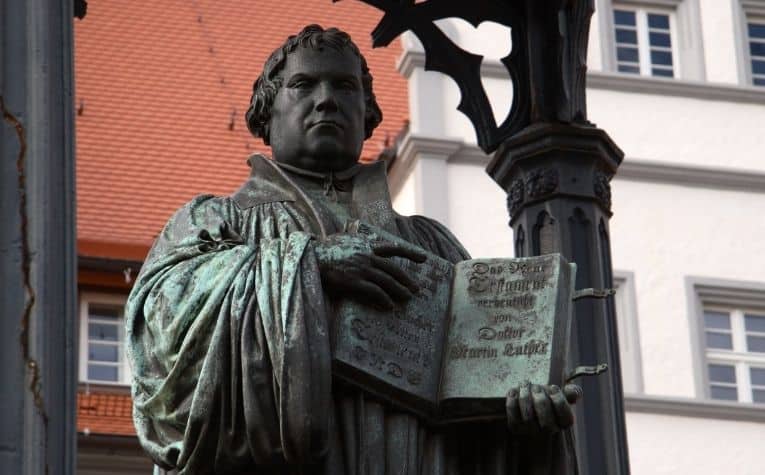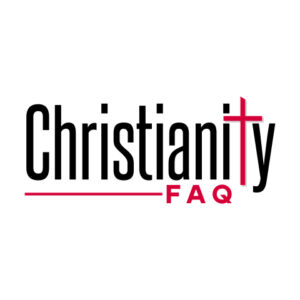Making the sign of the cross, which is a hand gesture that traces the vertical and horizontal beams over one’s head, chest, and shoulders, is commonly associated with Roman Catholicism. Yet other Christian traditions have historically used the gesture in prayer and worship, including Lutheranism.
Some Lutherans make the sign of the cross because their tradition’s founder, Martin Luther (1483-1546), encouraged the practice. He taught people to make the sign as an expression of faith during daily prayers and when experiencing spiritual warfare. Today, Lutherans are free to do it or not.
What is the point of making the sign of the cross, according to those that practice the gesture? What exactly did Luther teach about it? Do any other Protestants make the sign of the cross? Keep reading to learn more.

How Do Lutherans Make the Sign of the Cross?
The sign of the cross is a gesture made with the hand that traces the shape of a Christian cross. When a priest or minister traces the form on another person, they often perform the gesture in the air but close to the individual. When people trace the cross on themself, they often touch their head, chest, and shoulders.
How do people trace the cross on themselves?
The traditional way of performing the gesture is to touch the forehead, which marks the top of the cross. Then a person taps their chest, representing the cross’s bottom. Then they trace the horizontal beam of the cross from one shoulder to the other. (Also see What Do Lutherans Believe About Mary?)
People make the horizontal gesture from left to right in Western traditions like Roman Catholicism, Anglicanism, and Lutheranism. In the Eastern Orthodox tradition, people make it from right to left.
What does a person’s hand look like when they trace the cross?
The shape of the hand and fingers vary. Some traditions intend to convey theological truth with the hand’s form, but some don’t (more below).
In Western traditions that make the sign of the cross, a person’s hand is often open so the fingers aren’t interlaced or touching.
The open-hand shape reflects the five wounds of Christ in some traditions. In others, like in many Eastern Christian traditions, the thumb, index finger, and middle finger touch. Three fingers making one point represent the Trinity.
What do people say when making the sign of the cross?
Traditions vary, but in many cases, people appeal to the Trinity. First, they mention the Father when a person traces the top of the cross. Next, they refer to the Son when they trace the bottom of the cross.
Finally, they invoke the Holy Spirit when they trace the horizontal beam. Sometimes people say the phrase “in the name of the Father, Son, and Holy Spirit” when outlining the cross. (Also see Why Are Lutheran Churches Named After Saints?)
Why do people make the sign of the cross?
The sign of the cross is an expression of faith. It’s an outward gesture that signifies an unseen reality. Some people describe its meaning using the analogy of a wedding ring.
A wedding ring is an outward sign of an unseen reality. A wedding ring isn’t necessary to establish a relationship, but it’s a symbol of marriage that has meaning for a husband and wife.
Similarly, the sign of the cross, at least in Lutheranism, conveys no extraordinary power on its own. Instead, it’s a physical gesture that helps people consider and remember critical spiritual truths. (Also see Are Lutherans Born Again?)

What Did Martin Luther Teach About the Sign of the Cross?
Martin Luther encouraged Christians to make the sign of the cross routinely. He believed it was helpful to a person’s devotion to Christ. Luther even said making the sign of the cross is the first thing believers should do when waking up in the morning and the last thing they should do at night.
During morning prayers
Luther said, “In the morning, when you rise, you shall make the sign of the holy cross, and you shall say: ‘In the name of the Father, and of the Son, and of the Holy Spirit. Amen.’ Then, kneeling or standing, you shall say the Apostles’ Creed and the Lord’s Prayer.” [1]
During evening prayers
Luther said, “In the evening, when you go to bed, you shall make the sign of the holy cross, and you shall say: ‘In the name of the Father, and of the Son, and of the Holy Spirit. Amen.’ Then, kneeling or standing, you shall say the Apostles’ Creed and the Lord’s Prayer.” [2]
During spiritual warfare:
Luhter said, “To defy the devil, I say, we should always keep the holy name upon our lips so that he may not be able to harm us as he would like to do. For this purpose, it also helps to form the habit of commending ourselves each day to God – our soul and body, spouse, children, servants, and all that we have – for his protection against every conceivable need.”
He continued, “This is why the Benedicite, the Gratias, and other evening and morning blessings were also introduced and have continued among us. From the same source comes the custom learned in childhood of making the sign of the cross when something dreadful or frightening is seen or heard, and saying, ‘Lord God, save me!’ or, ‘Help, dear Lord Christ!’ and the like.” [3]
The Evangelical Lutheran Church of America also points out that Luther encouraged making the sign of the cross at baptism and during ordination services (see below). (Also see Do Lutherans Drink Alcohol?)

How did the sign of the cross start?
The biblical basis for making the sign of the cross lacks strong evidence, even though some cite verses in support of the practice (see below). Lutherans who practice the gesture, to extend the analogy used above, view it more like a wedding ring.
Many Christians who wear wedding rings realize there is no biblical basis for wearing them. Nevertheless, it’s an outward sign of an essential spiritual commitment.
People commonly cite three Bible verses to defend making the sign of the cross. To be clear, not all, or even most Lutherans, who make the gesture believe these verses describe the practice. Yet a minority found in different Christian traditions do.
- Genesis 4:15, “Then the Lord said to him, ‘Not so! If anyone kills Cain, vengeance shall be taken on him sevenfold.’ And the Lord put a mark on Cain, lest any who found him should attack him.” (ESV)
- Ezekiel 9:4, “And the Lord said to him, ‘Pass through the city, through Jerusalem, and put a mark on the foreheads of the men who sigh and groan over all the abominations that are committed in it.'” (ESV)
- Revelation 22:4, “They will see his face, and his name will be on their foreheads.” (ESV)
Furthermore, some early Christian writers, like Tertullian and Chrysostom, make positive comments about making the sign of the cross. (Also see Do Lutherans Pray the Rosary?)
Wisconsin Evangelical Lutheran Synod and the Sign of the Cross
The WELS, a conservative Lutheran denomination, teaches that making the sign of the cross can be beneficial, but it’s not necessary. WELS stresses that the practice is an exercise of a Christian’s freedom.
The denomination states, “Lutherans who do not join in that practice are also exercising their Christian freedom. Making the sign of the cross can be a helpful reminder that Christians are redeemed children of God—people who enjoy salvation only because of God’s forgiving love and not because of anything they have done (Ephesians 2:8-9; Titus 3:5-7).” [1]
Evangelical Lutheran Church of America and the Sign of the Cross
The ELCA, like the WELS, teaches that Lutherans are free to decide whether or not to make the sign of the cross. Yet whatever a person chooses, the gesture is still a significant part of Lutheran history: “The sign of the cross is a treasured part of our heritage as Lutherans, because the practice was encouraged and used by Martin Luther himself.”
The ELCA says that Luther taught the sign of the cross could be made on at least three occasions [5]:
- At baptism: “Receive the sign of the holy cross on both your forehead and your breast.” (Luther’s Works 53:107)
- At ordination: “The ordinator blesses them with the sign of the cross.” (Luther’s Works, 53:126)
- During prayer: see references above to morning and evening prayer.
References:
[1] “Prayers for Daily Use,” The Small Catechism, An Explanation of Dr. Martin Luther’s Small Catechism. p. 26
[2] Ibid.
[3] Large Catechism I:72-74, The Book of Concord. p. 395-96
[4] Source
[5] Source
[6] Source
Related Questions
The Lutheran tradition is a 500-year-old branch of Protestant Christianity. Non-denominational churches are a fast-growing segment of evangelical Christianity, especially in the United States and...
Baptist and Lutheran are two of Christian history's most influential Protestant denominations. Yet, while there are many commonalities between Baptist and Lutheran denominations, churches, and...
